Key takeaways:
- Pro-life advocacy emphasizes the inherent value of all human life and promotes a supportive culture for mothers and families.
- Youth involvement is essential, bringing fresh perspectives and fostering meaningful discussions that empower young voices in advocacy.
- Effective outreach strategies include utilizing personal stories, social media engagement, and interactive events to resonate with young people.
- Building a supportive community requires inclusivity, mentorship, and ongoing encouragement to transform young individuals into active advocates.
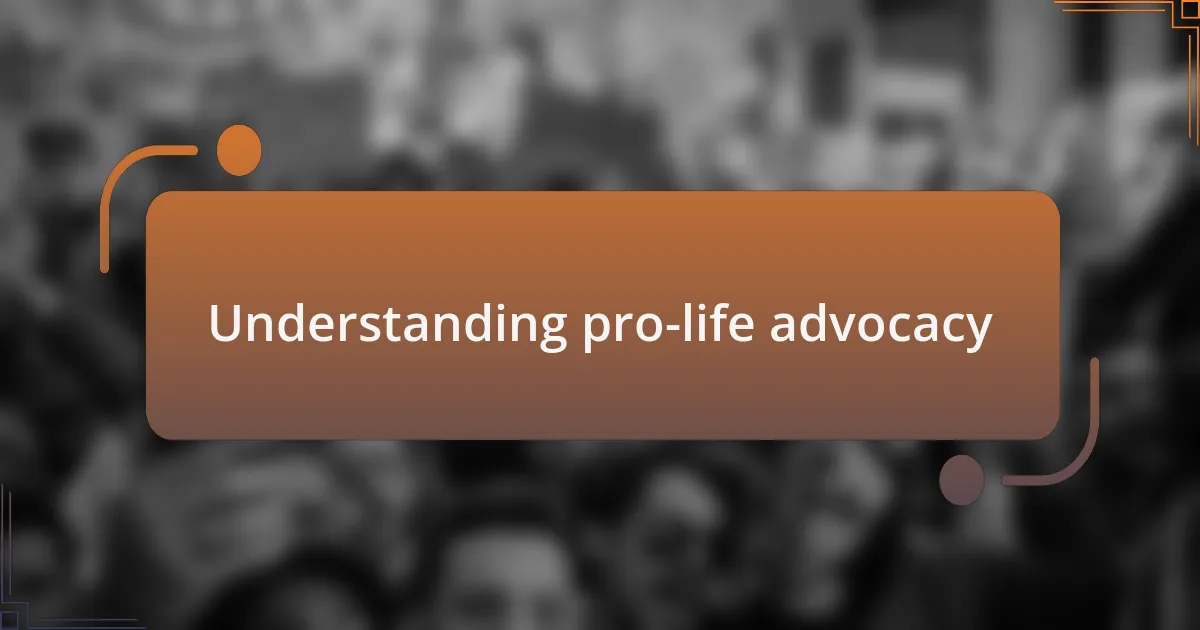
Understanding pro-life advocacy
Pro-life advocacy centers on the belief in the inherent value of every human life, from conception to natural death. I often reflect on my own journey in this movement, realizing that my understanding deepened with every conversation, particularly those with young people eager to share their perspectives. Have you ever considered how one conversation can change the trajectory of someone’s beliefs?
As I engaged with various groups, I discovered that being pro-life isn’t just about opposing abortion; it’s about promoting a culture that supports mothers, families, and the sanctity of life. I remember attending a local rally where a young mother shared her story of hope and resilience after choosing life for her child, despite facing immense obstacles. Her words resonated with everyone present, showcasing the real-life implications of our advocacy.
This journey involves addressing complex emotional and ethical questions that many grapple with. I’ve often pondered, how can we better communicate the value of life in a society saturated with competing narratives? Hearing personal stories can be a powerful tool for change, and I believe that genuine dialogue can bridge understanding across divides.
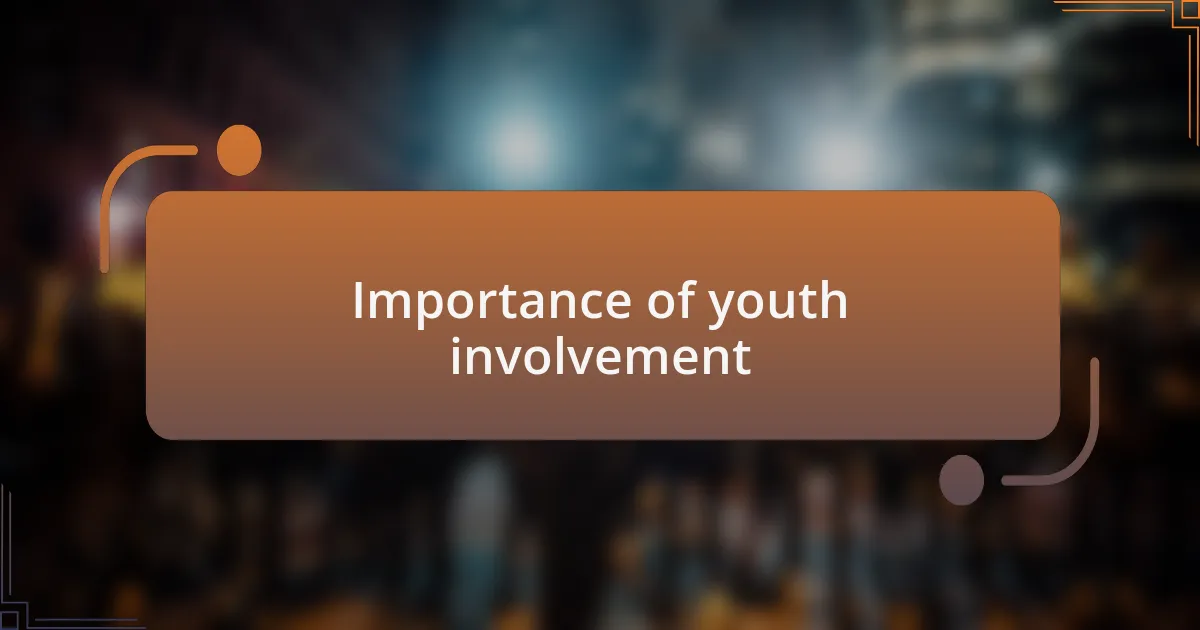
Importance of youth involvement
When I think about the importance of youth involvement in pro-life advocacy, I realize that young voices bring a fresh perspective that can invigorate the movement. I once mentored a high school student who organized a discussion panel on reproductive health at her school. Watching her articulate her passion and gather peers to engage in meaningful conversations was a powerful reminder of how youth can foster change through dialogue.
Youth involvement is crucial not just for the present but for the future. I recall a lively debate I attended, where young advocates passionately debated ethical considerations surrounding life choices. It struck me how these discussions not only educated their peers but also planted seeds of compassion and understanding that could blossom into a more supportive community. Why should we limit these conversations to only adults when the experiences and insights of young people are just as valuable?
Moreover, I believe that engaging youth in pro-life advocacy empowers them to take ownership of their beliefs. It’s inspiring to witness young individuals transform from being passive observers to active participants. In my experience, when I see teens rallying together for a cause, it ignites a passion in me, as I remember my own youth spent fighting for what I believed in. Isn’t it vital for them to feel that their opinions matter in shaping the values of tomorrow?

Strategies for effective outreach
Engaging youth in pro-life initiatives requires strategies that resonate with their values and communication styles. I remember coordinating a community event where we utilized social media to share personal stories of advocacy. The response was overwhelming, and it was a clear testament to how relatable narratives can ignite passion and encourage participation among young people. Have you ever noticed how compelling stories often prompt others to join in?
Another effective outreach strategy is collaborating with youth organizations that already have established trust and rapport with their members. I’ve found that partnering with local schools or youth clubs amplifies our message and fosters authenticity. During one such partnership, we organized a workshop that combined art and advocacy, allowing students to express their views creatively. It was incredible to see how their artistic expressions translated into a deeper understanding of pro-life issues.
Finally, tailoring outreach efforts to include interactive elements can enhance engagement. I once facilitated a debate series for teens, encouraging them to voice their thoughts on various topics related to pro-life advocacy. The energy in the room was electric; not only did they learn from each other, but they also recognized the importance of their voices in shaping societal narratives. Why not create opportunities for discussions that empower them to be heard?
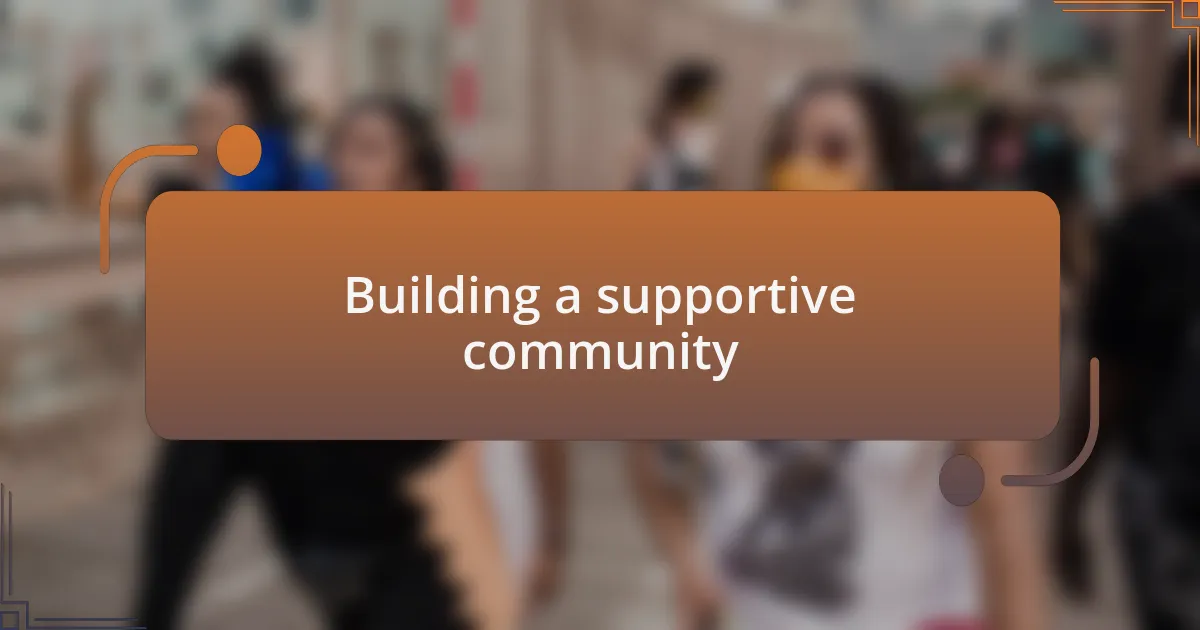
Building a supportive community
Building a supportive community starts with creating an inviting atmosphere where everyone feels valued and heard. When I first volunteered at a local pro-life group, we organized small gatherings to discuss our values and experiences. It was amazing to see how sharing personal stories fostered connections; one young woman shared how her journey led her to advocate for life, and I could feel the room shift with empathy and understanding. Have you ever felt the power of shared experiences in bringing people together?
Another important aspect is ensuring that support extends beyond events; it should be woven into the fabric of the community. I recall a time when we implemented a mentorship program that paired experienced advocates with newcomers. The transformation I witnessed in those relationships was profound. The bonds formed helped youth navigate challenges more confidently, and it highlighted the need for ongoing encouragement and support. Isn’t it uplifting when someone believes in your potential?
Lastly, inclusivity is vital for a thriving community. During one of our outreach campaigns, we made a concerted effort to engage individuals from diverse backgrounds. I was struck by how different perspectives enriched our discussions and brought new energy to our initiatives. The vibrancy of voices in that space not only broadened our understanding but also deepened our commitment to advocating for life collaboratively. How can we harness that diversity to strengthen our mission?
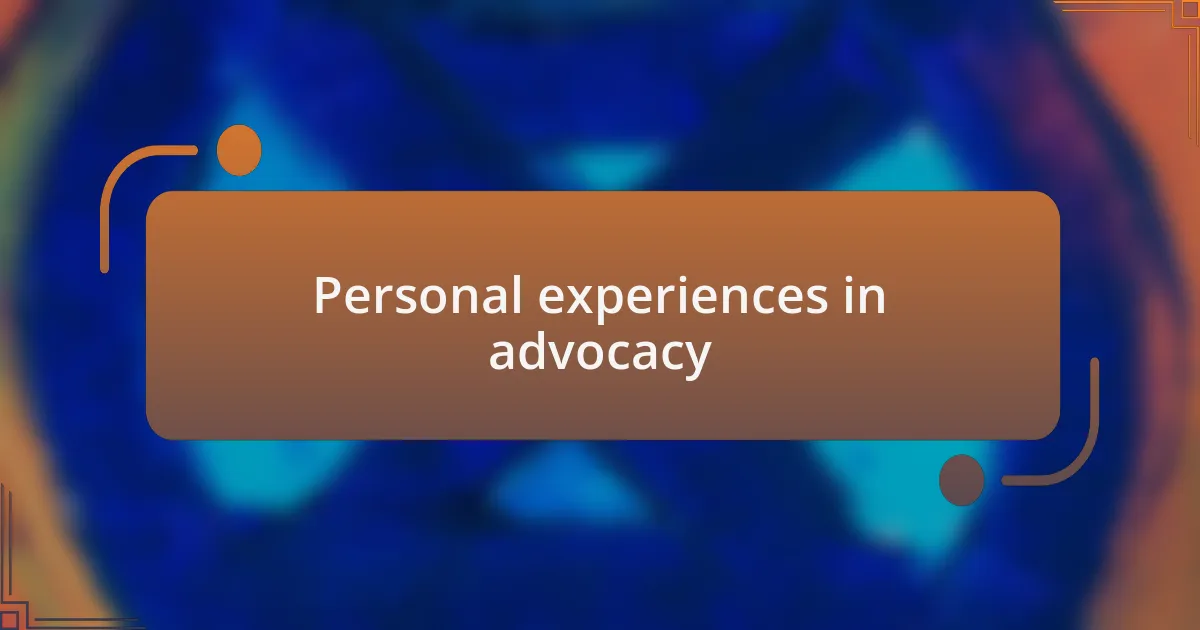
Personal experiences in advocacy
Advocacy for youth involvement has often been a deeply personal journey for me. One memorable experience was when I organized a youth-led event focused on the importance of life. I still remember the nervous faces of the young speakers as they prepared to share their stories. But when they stepped up, their passion electrified the room. Seeing their courage inspired me to be a better advocate. Have you ever witnessed someone transform under the spotlight?
There was a time when I partnered with a group of teenagers to create a social media campaign. I was initially intimidated by their tech savvy, but I also realized how powerfully they could convey our message. After brainstorming sessions filled with laughter and creativity, we launched the campaign. The response was unexpectedly robust, amplifying our reach and showing me that youth engagement isn’t just beneficial; it can be revolutionary. How often do we underestimate the impact that young voices can have?
One of the most poignant moments in my advocacy journey occurred during a community debate. I watched as a youth participant boldly defended their views, articulating beliefs rooted in personal experience. It reminded me just how much passion resides in the hearts of young advocates. After the debate, that participant approached me, expressing gratitude for creating a platform for their voice. Their words resonated with me, emphasizing that providing opportunities for youth to engage is not just about awareness—it’s about empowerment. Isn’t that what we aim for in our advocacy efforts?
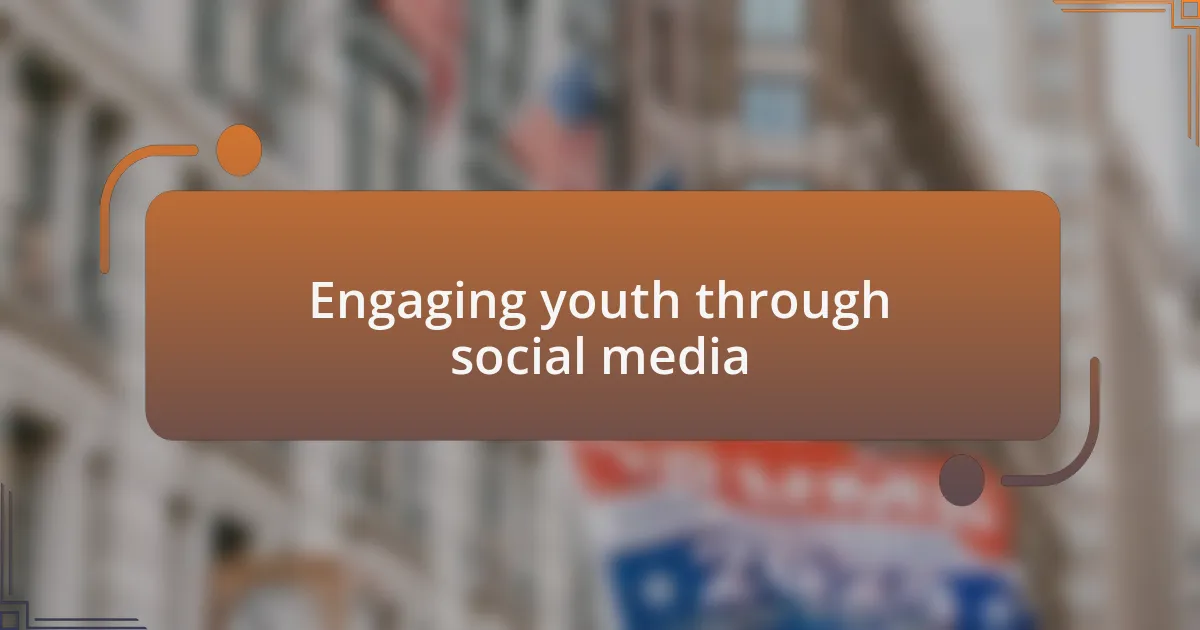
Engaging youth through social media
Engaging youth through social media can unlock their potential in advocacy like nothing else. I vividly recall a time when a young friend of mine shared a powerful video on social media, highlighting the personal stories of individuals affected by the pro-life movement. The post sparked a wave of comments and discussions among peers, reminding me of how much influence youth can wield in shaping conversations online. Have you ever seen something go viral, igniting a change in perspective?
I also experimented with various platforms, aiming to understand where youth felt most comfortable expressing their beliefs. One afternoon, I hosted an Instagram Live session, inviting teens to share their thoughts on critical issues surrounding life and choice. The energy was palpable as they began to speak, and I found myself captivated by their unfiltered honesty. It made me realize how social media isn’t just a tool—it’s a canvas for them to paint their views and connect with like-minded individuals. Isn’t it fantastic to witness such genuine empathy and activism unfold in real time?
Moreover, I noticed how memes and engaging graphics can communicate complex ideas in an easily digestible way. I once collaborated with a talented graphic designer (a high school student, no less) to create impactful visuals that drove home our pro-life message. The interactions we garnered from those posts were incredible, proving that creativity is just as crucial in advocacy. How can we harness that creativity to fuel more youth involvement?
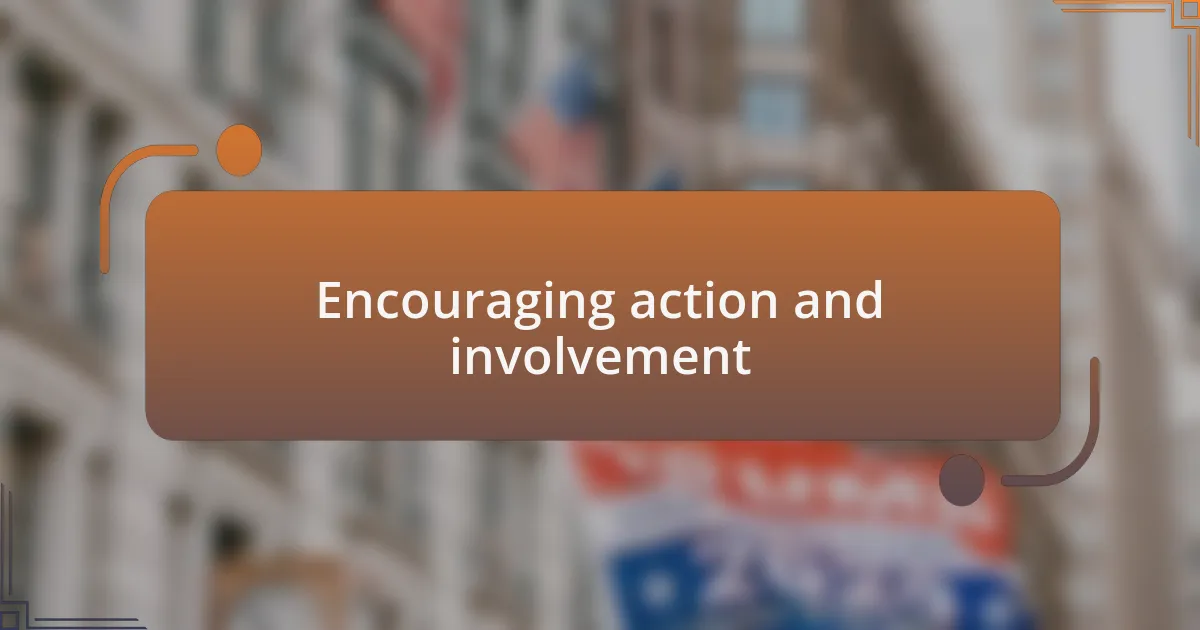
Encouraging action and involvement
One of the most effective ways to encourage youth action is through hands-on experiences that empower them to advocate in their communities. I remember organizing a local rally where young people could express their views and demonstrate their commitment to the pro-life cause. It was inspiring to watch them step up to the microphone, sharing their thoughts with authenticity and passion. Have you ever seen a young person light up when they realize their voice matters?
Additionally, I often emphasize the importance of mentorship. I once paired a group of younger advocates with seasoned leaders in our community. The transformation I witnessed during those interactions was remarkable; young advocates found not just guidance, but a sense of belonging. It begs the question: how can we create more opportunities for these generational connections?
Lastly, creating advocacy challenges can spur involvement in a fun way. I initiated a “30-day Challenge” where participants would engage in one act of advocacy each day, whether it was sharing a positive story, volunteering, or simply sparking conversation. The shared excitement on their faces as they completed each challenge was contagious. What if we turn advocacy into a game that everyone wants to play?